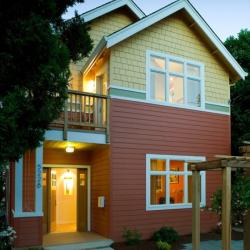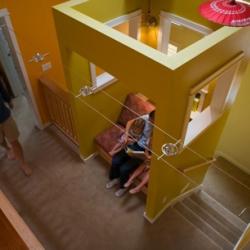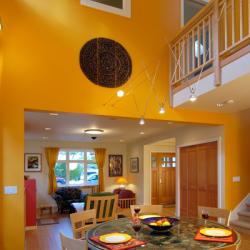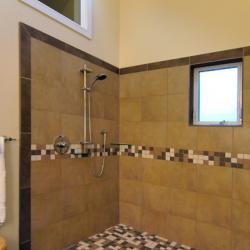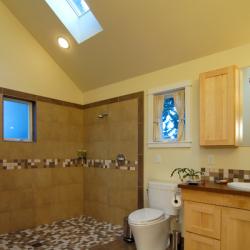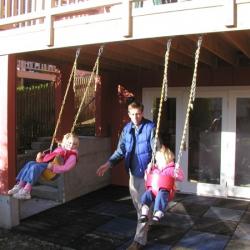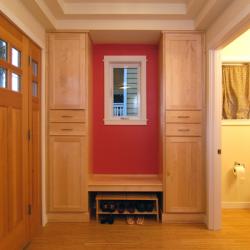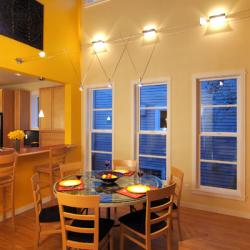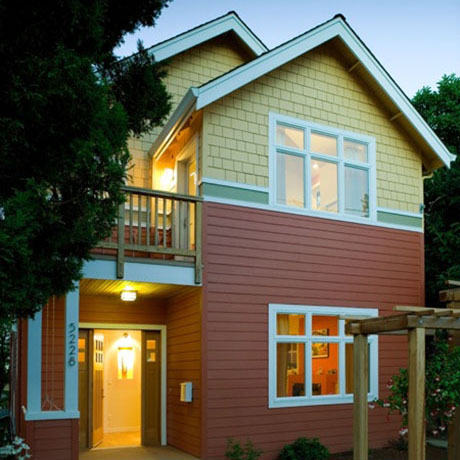
Introduction
Seattle is a city in the State of Washington in the Pacific Northwestern corner of the US set in an extraordinarily beautiful natural setting on Puget Sound with lakes, rivers, forests, islands and mountains in abundance. It's 600,000 people live in dense residential neighborhoods in a mix of predominantly single family homes on small lots with private yards. The Baldwin house is a three-story single family home in an established neighborhood designed by the architect owner for his young family. He committed at the outset to design a home that would integrate universal design and environmental sustainability. The design reflects elements of the historic Seattle bungalow style that blends with the vernacular of the neighborhood but it differs dramatically in dozens of subtle and effective details from the front sidewalk through every room. The architect set a high priority on flexible features that could change over the course of time in response to changing needs of his family and to accommodating their large extended four-generation family. The home emanates a sense of welcome and warmth but also delivers surprising experiences of delight in the clever design of small intimate spaces and inventive access to daylight.
Description
This three-story home is located in Seattle’s Greenlake neighborhood, a dense neighborhood of two and three family homes. This project replaces a small deteriorated home that could not be saved so it is an “in-fill” project. A level front entrance makes it easy to move bikes and strollers in and out.
Gently sloping paths connect the basement to a rear alley. All doors are wide (3'-0") for enhanced maneuverability, and the house has level thresholds at all exterior doors, uses only lever handles, and has curb-less showers. Indicative of the commitment to flexible solutions, the bathroom lavatory includes a base cabinet that looks like a single unit but actually has locking casters that allow it to be moved out should open space under the sink every be necessary. Three stacking closets are framed, sized and wired for a future elevator should it needed or desired.
The second floor closet has been left open and fitted with an upholstered bench and bookshelves. It offers a view and a cozy spot for children or adults. The double height ceiling in the dining room on the main floor offers a view to a second floor bridge that connects the master suite with the children's bedrooms. The side-walls of the open space were framed to accommodate the addition of another room should it be desirable in the future. The basement is designed to meet a range of needs. It’s currently a home office but could be an in-law apartment or rental unit. The flexible options for future renovation make it a very marketable asset to a wide range of homebuyers.
Storage has been thoughtfully designed and it’s plentiful. Built-in wood cabinetry becomes a signature feature of the house including an entry foyer with generous storage for coats and miscellany. The built-ins also include shoe storage and a bench. A toilet room is right off the foyer.
The design makes the most of the work and play spaces on each level. The children each have a loft in their bedroom that allows them choice. It’s a detail that could also benefit children with developmental issues who need spaces that allow them a small cozy get-away from the more public spaces of home or school.
Photos
Exterior View
Photo Credit:
Stacked Closet
Photo Credit:
Dining Area
Photo Credit:
Curbless Shower
Photo Credit:
Removable Base Cabinets
Photo Credit:
Basement Patio
Photo Credit:
Front Foyer
Photo Credit:
Dining Area Windows
Photo Credit:
Design and the User Experience
The residents of the house are a middle-income, white professional couple with two small children. No one in the family has a functional limitation. Their large extended families and many friends include some occasional visitors with disabilities.
Since the home is in a residential neighborhood, there is parking along the street and also off the alley. The streets are bike friendly, and the adults park their bikes in a shed off of the alley. The children’s bikes are in the first floor closet. There are no steps at either the main floor or basement entries, so wheeled devices are easily used. All ground surfaces are hard and smooth to allow for ease of mobility.
Emory R. Baldwin, AIA and his wife and their two young children are the users, and they designed the house. Although the architect husband was the primary designer, his wife was deeply involved in the design and planning of the home.
Their friend and colleague (Susan Duncan, of ADAptations) was also consulted on the design of the home. Otherwise, the owner/architect was the primary "expert" on Universal Design.
Evaluation
Although the lot is narrow (33’-6” wide), the house feels spacious due to its open layout. There is a center “hub” with a high vertical space over the dining room to enhance the sense of openness. This makes it easier to communicate with people between floors. Additionally, there are adjoining lofts looking over the children’s bedrooms. A door between them has locks on both sides so that both kids have to agree to have it open.
Recognizing that our needs will change over time, we have created flexible spaces. For example, the basement is designed to be a comfortable mother-in-law apartment. It is currently used as a large home office and exercise room, and can be used as a recreation room when the children are older. The structure of the side walls of the open space is designed to accommodate another room, should it ever be needed in the future. The room adjacent to the kitchen is currently a play area, but in the future it can be used as a family, music, or dining room.
The home incorporates many features of Universal Design and flexibility, and allows the home to accommodate the various physiological and socio-economic changes that a person is likely to experience over the course of their lives. The owners built the house keeping in mind the varying abilities that people have, and they found that they have greatly benefited from it.
The door to the powder room swings in, which makes it awkward for wheelchair users. The door was supposed to swing both ways to accommodate people’s different preferences, but the wrong door was installed. Although several people using wheelchairs have used the powder room without complaint, the owner wishes to reverse the swing of the door.
On the upper level, the doors to the laundry room and children’s bathrooms swing in, which again make it awkward for wheelchair users. The wife wanted the doors to swing in and the husband wanted the doors to swing out, so the doors were located in a way that would allow the doors to be easily reversed. The owners will likely reverse these door swings in the near future so that they do swing out for greater accessibility.
The hallway in the basement is 42” wide clear, which is fine for passage, but the owner wishes that they had made it even wider so that it would be easier to maneuver into the future elevator at that location.
Also, the kitchen sink was intended to have a removable base cabinet (like the ones at the bathroom vanities), but the plumber located the waste pipes in a way that made this impossible. The owner / architect considered having the plumber correct this work, but decided against it since it would have slowed down the rest of the construction due to sequencing and scheduling issues.
Universal Design Features
- There are accessible gently sloping paths to both the front entry (from the street) and the rear entry (from the alley).
- There are no steps going into the house, which makes it easy for anyone using wheels from strollers to bicycles to rolling suitcases and shopping carts as well as someone using a wheelchair or a scooter. All of the exterior doors have level thresholds.
- All door handles and cabinet pulls are designed to be easy to open for people with limited hand dexterity, and they are also easy for us to use when our hands are full.
- A shelf next to the front door for resting packages on while trying to find your keys. * All doors throughout the house are wide (3'-0") for enhanced maneuverability and are convenient for moving furniture and large objects around. * The stairs wrap around three stacked closets, which are sized and wired for a future elevator should the need arise someday. Currently, the extra-deep closet space provides storage for strollers and tricycles. The upstairs section of the closet is used as a reading nook for bedtime stories.
- The showers are all curb-less which allows someone with a disability to roll in using their wheelchair, and eliminates a potential tripping hazard. The shower controls are offset, so a caregiver could easily operate them without getting wet.
- The bathrooms sinks have removable base cabinets on lockable caster wheels that may be rolled away when the resident needs to be in a seated position.
- The kitchen has several Universal Design elements including: a wall oven at accessible height, a wide clearance between the island and counter, a sink with a pull-out spray near the stove for filling pots, and a smooth glass energy-efficient induction cook top allows for easy transfer of pots and pans, and is safe for our children because it doesn’t get too hot. The controls of the cooktop are lockable and are located along the front so that the user does not need to reach across the burners to adjust the heat level.
- The main level has smooth wood flooring which reduces tripping and makes it easier to use wheeled objects. Efficient radiant heating under the floor creates comfortable, even temperatures and eliminates the need for ducts and vents, thus making it easier to arrange furniture.
- Used playground tiles under the deck were made from recycled tires which provide a soft enough surface for falling on, but also a firm enough surface for a tricycle or wheelchair.
Environmentally Sustainable Features
- The flooring on the main floor is made from wood scraps taken from manufacturers of engineered wood beams, and milled into flooring.
- Deck and porch surfaces are made of composite decking made from recycled plastic and reclaimed wood, and never need to be painted or stained.
- The exterior railings are made from locally harvested cedar, a renewable resource and resistant to rotting.
- The siding is made of local fiber cement, which is non-toxic, durable, and low maintenance and made locally in Tacoma, Washington.
- Re-used playground tiles (made from recycled tires) are used for the ground surface at the basement patio.
- The carpeting in the basement and on the upper floor is tightweave for accessibility and is made from recycled soda bottles.
- Kitchen backsplashes are made from sections of old chalkboards salvaged from a local high school that was undergoing renovation.
- The house is oriented for good solar access, and all windows have low emissivity and high U-values.
- All landscaping is drought-tolerant, which reduces water usage.
Project Details
Baldwin Residence
5228 Kirkwood Pl. N.
Seattle, WA 98103
www.zai-inc.us
Single Family Residence
New Construction
Completed November 2006
Construction Cost: $447,000
Total Project Cost $747,000 (including land)
Project Team
Client: Emory and Laura Baldwin
Project Manager: Emory Baldwin
Architect: Emory Baldwin
Universal/Inclusive Design Consultant: Susan Duncan, The ABC’s of Accessibility Inc.
Contractor: John Breyer, Lakeland Builders, Inc.
Engineer: John Riley, Quantum Consulting Engineers LLC
Public Agency, Authority Oversight or Partnership: David Hudacek, City of Seattle Department of Planning and Development
Additional information
Awards
- AIA Small Projects Award 2008 Further information: www.zai-inc.us
- First Place (Honor Award), National AIA Small Project Award (for “Accessible Residence Design” category) March, 2009
Publications
- Housing in Response to the Human Life Cycle: A Test House in Seattle’s Green Lake Neighborhood Ultimate Home Design July-August, 2007
- Housing in Response to the Human Life Cycle, Builder News, August, 2007
- One to Grow On, (Feature Article on Home Design) Seattle Metropolitan Magazine, March, 2009
Media Coverage
- A House that Grows with You, (on ‘Sound Focus’ – Dave Beck, Host), NPR – KUOW, 94.9 FM, June & October, 2008
- Emory Residence, (On-line video and interview about Universal Design), Studio G4, www.studiogfour.com, July, 2009
Funding By


Propose a Case Study
Help us improve our Case Study library

